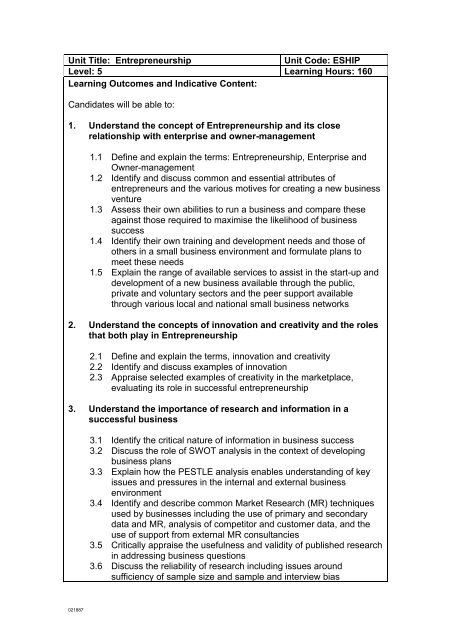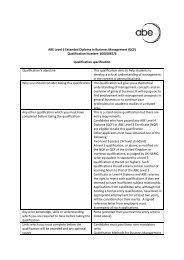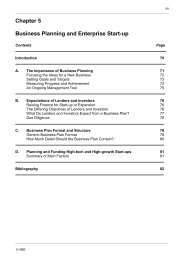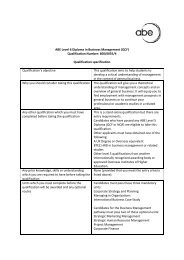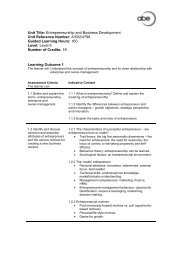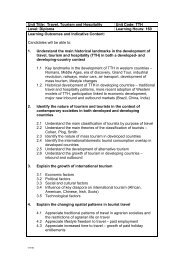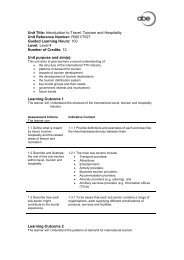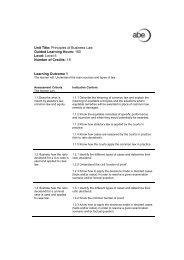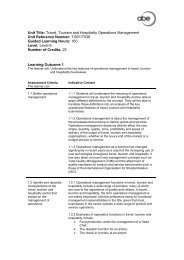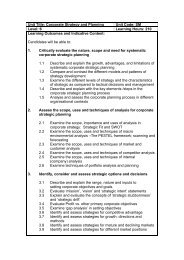Unit Title: Entrepreneurship Unit Code: ESHIP Level: 5 Learning ...
Unit Title: Entrepreneurship Unit Code: ESHIP Level: 5 Learning ...
Unit Title: Entrepreneurship Unit Code: ESHIP Level: 5 Learning ...
- No tags were found...
Create successful ePaper yourself
Turn your PDF publications into a flip-book with our unique Google optimized e-Paper software.
<strong>Unit</strong> <strong>Title</strong>: <strong>Entrepreneurship</strong><strong>Unit</strong> <strong>Code</strong>: <strong>ESHIP</strong><strong>Level</strong>: 5 <strong>Learning</strong> Hours: 160<strong>Learning</strong> Outcomes and Indicative Content:Candidates will be able to:1. Understand the concept of <strong>Entrepreneurship</strong> and its closerelationship with enterprise and owner-management1.1 Define and explain the terms: <strong>Entrepreneurship</strong>, Enterprise andOwner-management1.2 Identify and discuss common and essential attributes ofentrepreneurs and the various motives for creating a new businessventure1.3 Assess their own abilities to run a business and compare theseagainst those required to maximise the likelihood of businesssuccess1.4 Identify their own training and development needs and those ofothers in a small business environment and formulate plans tomeet these needs1.5 Explain the range of available services to assist in the start-up anddevelopment of a new business available through the public,private and voluntary sectors and the peer support availablethrough various local and national small business networks2. Understand the concepts of innovation and creativity and the rolesthat both play in <strong>Entrepreneurship</strong>2.1 Define and explain the terms, innovation and creativity2.2 Identify and discuss examples of innovation2.3 Appraise selected examples of creativity in the marketplace,evaluating its role in successful entrepreneurship3. Understand the importance of research and information in asuccessful business3.1 Identify the critical nature of information in business success3.2 Discuss the role of SWOT analysis in the context of developingbusiness plans3.3 Explain how the PESTLE analysis enables understanding of keyissues and pressures in the internal and external businessenvironment3.4 Identify and describe common Market Research (MR) techniquesused by businesses including the use of primary and secondarydata and MR, analysis of competitor and customer data, and theuse of support from external MR consultancies3.5 Critically appraise the usefulness and validity of published researchin addressing business questions3.6 Discuss the reliability of research including issues aroundsufficiency of sample size and sample and interview bias021887
4. Understand how to prepare a sales and marketing plan and manageits implementation4.1 Describe what is meant by the term ‘product’ including theconcepts of core, actual and extended product4.2 Explain the importance of differentiating the product and fordeveloping product, brand and corporate USPs (Unique SellingPoints)4.3 Discuss the challenge faced by the business with limited resourcesof developing products which meet identified needs, and possiblestrategies to achieve this4.4 Describe the features of a product development process4.5 Explain the concept of the product life-cycle situations and theimportance of continual monitoring of product performance andproduct innovation to extend its life4.6 Discuss the importance of corporate positioning and branding tothe business4.7 Describe the range of marketing strategies and methods that abusiness might use4.8 Describe the key elements of marketing plans explaining how theseare developed4.9 Discuss the benefits of integrated market planning4.10 Describe the functions of public relations, marketing and sales andtheir inter-connected relationships5. Understand regulatory frameworks affecting the entrepreneur (UK)5.1 Understand the relevant regulations for the entrepreneur under theData Protection Act5.2 Identify relevant aspects of accountancy regulations and theirimpact upon start-up procedures5.3 Describe the requirements necessary to conform with the relevantadvertising standards code of conduct5.4 Explain the implications of the market research society code ofconduct5.5 Discuss legal risk in new business start-ups6. Understand the relationship of costing to the firm’s pricingdecisions6.1 Describe the types of costs a firm faces and the calculationsnecessary to accurately cost the provision of its products tocustomers6.2 Explain what is meant by cost-plus and market pricing strategies6.3 Describe what other pricing strategies might be available to the firmto use in a variety of market and product life-cycle situations6.4 Discuss the usefulness of customised pricing and discounting tothe business021887
7. Understand issues and decisions involved in financing andresourcing a business start-up and essential aspects of financialmanagement7.1 Explain how a business can effectively assess its start-up financingrequirements including how it might assess its resource andpremises needs7.2 Describe the sources of finance available to new businesses andthose in early development and identify and describe potentialsolutions7.3 Discuss common financial difficulties experienced by newbusinesses and those in early development and identify anddescribe potential solutions, explaining the pros and cons ofdifferent types of finance available7.4 Describe the key indicators of the financial health of a business andhow these can be effectively monitored and acted on7.5 Describe key elements of financial management and control insmall business8. Understand the enterprise culture8.1 Define the enterprise culture in business and the pros and cons ofdeveloping such an approach8.2 Select a prominent entrepreneur and research their businessachievements, their public persona and their approach toenterprise culture in order to identify key attributes or decisions thathave led to their entrepreneurship and its effect upon the business8.3 Describe the concept of intrapreneurship and its effect upon thebusiness8.4 Understand the factors which militate against an enterprise culture8.5 Describe the processes involved in the development of competitiveadvantageAssessment Criteria:• Assessment method: written examination• Length of examination: three hours• Candidates should answer four questions from a choice of eight, eachquestion carrying equal marks.Recommended Reading and ResourcesAcademy of <strong>Entrepreneurship</strong> Journals – http://www.alliedacademies.org/entrepreneurship/index.htmlBabson College, USA – Frontiers of <strong>Entrepreneurship</strong> Research –http://www.babson.edu/entrep/fer/021887
Barrow C, Financial Management for the Small Business: A Practical Guide(2006), Kogan Page: London, 6 th editionBessant J and Tidd J, Innovation and <strong>Entrepreneurship</strong>, John Wiley & SonsLtd, West SussexBlankson C and Stokes D, Marketing Practices in the UK Small BusinessSector, Marketing Intelligence and Planning (2002), Vol. 20, No. 1, pp.49–61Bridge S, O’Neill K and Cromie S, Understanding Enterprise,<strong>Entrepreneurship</strong> and Small Business (2003), Macmillan Press: Basingstoke,2 nd editionBurns P, Corporate <strong>Entrepreneurship</strong>: Building an EntrepreneurialOrganisation, Palgrave Macmillan: Basingstoke (2005)Chell E, The Entrepreneurial Personality: A Social Construction (2005),Routledge: LondonCorbett AC, Experiential <strong>Learning</strong> within the Process of Opportunity,<strong>Entrepreneurship</strong> Theory and Practice (2005), Vol. 29, No. 4, pp. 473–491Detienne DR, and Chandler GN, Opportunity Identification and Its Role in theEntrepreneurial Classroom: A pedagogical Approach and Empirical Test,Academy of Management: <strong>Learning</strong> and Education (2004), Vol. 3, No. 3,pp. 242–257, Drucker, P (archive)http://drucker.cgu.edu/DruckerArchives/data/index.htmEntrepreneur.com – http://www.entrepreneur.comESRC Centre for Research on Innovation and Competition –http://www.cric.ac.ukEuropean Commissioner’s Enterprise and Innovation Directorate –http://www.cordis.lu/innovation-policy/studiesGray C, <strong>Entrepreneurship</strong>, Resistance to Change and Growth in Small Firms,Journal of Small Business and Enterprise Development (2002), vol. 9, No. 1,pp. 61–72Harris L, Employment Regulation and Owner-Managers in Small Firms:Seeking Support and Guidance, Journal of Small Business and EnterpriseManagement, (2000), vol. 7, No. 4, pp. 352–362Pinchot III G, Intrapreneurship, http://www.intrapreneur.comKao JJ, The Art & Discipline Of Business Creativity: Strategy & Leadership(1997), vol. 25, pp. 6–11021887
Lowe R and Mariott S, Enterprise: <strong>Entrepreneurship</strong> and Innovation:Concepts, Contexts and Commercialization (2006), Oxford: ButterworthHeneimannMaitland I, The Small Business Marketing Handbook (1998), London, CassellRunning a Business (BBC) –http://news.bbc.co.uk/1/hi/in_depth/business/2003/small_business/default.stmSiu W and Kirby D A, Approaches to Small Firm Marketing: A Critique,European Journal of Marketing (1998), Vol. 32, No. ½, pp. 40–60Small Business.co.uk. – http://www.smallbusiness.co.uk/Small Business Research Portal –http://www.smallbusinessportal.co.uk/index.phpSmall Business Research Trust – http://www.sbrt.co.ukSmall Business Service – http://www.smallbusinessservice.gov.uk/ orhttp://www.sbs.gov.uk/Small Firm Enterprise Development Iniative (SFEDI) – http://www.sfedi.co.uk/UK’s National Council for Graduate <strong>Entrepreneurship</strong> –http://www.ncge.org.ukStarting up in Business – http://www.startups.co.uk/Taylor DW and Pandza K, Networking Capability: The Competitive Advantageof Small Firms (chapter) in Competitive Advantage in SMEs: Organising forInnovation and <strong>Entrepreneurship</strong> (2003), Jones O & Tilley F (eds), John Wiley& Sons Ltd. Chicester, pp. 157–174Webb P and Webb S, The Small Business Handbook: An Entrepreneur’sDefinitive Guide to Starting a Business and Growing a Business (2001),Financial Times Series, London, FT/Prentice HallWickham PA, Strategic <strong>Entrepreneurship</strong> (2006), 4 th edition, London,FT/Prentice HallWilliams S, The “Financial Times” Guide to Business Start Up 2008 (2008),London FT, Prentice Hall021887


